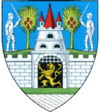- Carei
-
Carei
Nagykároly— Municipality — The Károlyi castle in Carei 
Flag
Coat of armsLocation of Carei Coordinates: 47°41′2.28″N 22°28′0.73″E / 47.6839667°N 22.4668694°ECoordinates: 47°41′2.28″N 22°28′0.73″E / 47.6839667°N 22.4668694°E Country  Romania
RomaniaCounty Satu Mare County Status Municipality Government – Mayor Kovács Jenő (Democratic Union of Hungarians in Romania) Area – Total 102 km2 (39.4 sq mi) Population (2007) – Total 22,611 (INSSE Statistic) Time zone EET (UTC+2) – Summer (DST) EEST (UTC+3) Website http://www.primariacarei.ro/ Carei (Romanian pronunciation: [kaˈrej]; German: Grosskarol/Großkarl; Hungarian: Nagykároly, Hungarian pronunciation: [’nɒɟkaːroj]; Yiddish: קראלי (Karaly)) is a city in Satu Mare County, northwestern Romania, near the border with Hungary. It has 23,000 inhabitants (2004): 53% Hungarians, 40% Romanians, 3% Roma, and 3% Germans.
Contents
Name
The city was named after an old noble family, the Károlyi. Carei administers one village, Ianculeşti (Hungarian: Szentjánosmajor). The neighbouring communities are Hungarian-speaking villages of German origin, such as Căpleni, Urziceni, Foieni, Sanislău, Petreşti, Tiream, Căuaş and Moftin.
History
The first historical document mentioning the name of the city dates form March 20, 1320. The settlement was called at the time "villa Karul".
According to written sources,[which?] King Louis I of Hungary permitted the organization of weekly market gatherings in Carei in 1346. The development of the trade in the region stimulated the wealth and expansion of the city.
Wars, plague and famine during the Middle Ages decimated the population and the Karoly family took steps in bringing Swabians on their lands.[citation needed] The first group of colonists came in 1712, opening a century-long period of gradual colonization with Swabians, Slovaks, and Jews.[citation needed] Effects on cultural and social life began to show: in 1725 the Piarist Gymnasium was established, in 1754 the first typography was built, and in 1756 a drugstore was opened. The light industry began to bloom in the city starting with the 19th century, when the first public institutions[which?]were also created. Carei was declared a city in 1871.
Carei was taken from Hungarian and German troops by Romanian and Soviet forces on October 25, 1944. This date has since become the Romanian Army Day. After the war ended Carei was assigned to Romania by the Treaty of Paris of 1947. Since then, Carei was located in the Baia Mare Region between 1952 and 1960, in the Maramureş region between 1960 and 1968, and since 1968, it has been part of the Satu Mare County.
Climate
Carei has a continental climate, characterized by hot dry summers and cold winters. As the city is in the far north of the country, winter is colder than the national average. The average annual temperature is 9.6 °C (49 °F).[1]
Climate data for Satu Mare Month Jan Feb Mar Apr May Jun Jul Aug Sep Oct Nov Dec Year Average high °C (°F) 1
(34)3
(37)10
(50)15
(59)20
(68)22
(72)25
(77)25
(77)21
(70)15
(59)7
(45)2
(36)13 Average low °C (°F) −5
(23)−3
(27)1
(34)5
(41)9
(48)12
(54)13
(55)13
(55)10
(50)5
(41)0
(32)−2
(28)5 Precipitation cm (inches) 2
(0.8)2
(0.8)2
(0.8)4
(1.6)7
(2.8)8
(3.1)8
(3.1)7
(2.8)4
(1.6)4
(1.6)3
(1.2)2
(0.8)59
(23.2)Source: weatherbase.com[2] Tourism
The most important historical building in the city is the Károlyi castle. Built originally as a fortress around the 14th century, it was converted to a castle in 1794, undergoing further transformations during the 19th century. The manor is surrounded by a dendrological park covering a surface of about 30 acres (120,000 m2) and containing a great variety of species of trees and plants.
International relations
See also: List of twin towns and sister cities in RomaniaTwin towns — Sister cities
Carei is twinned with:
References
- ^ "Geografie" (in Romanian). www.satu-mare.ro. http://www.satu-mare.ro/despre/localizare.html. Retrieved 2009-06-22.
- ^ "Weatherbase data for Satu Mare". http://www.weatherbase.com/weather/weatherall.php3?s=1051&refer=&units=metric. Retrieved 2009-06-22.
Gallery
-
Saint Joseph Calasanctius Church
External links
- Official site of Carei (Romanian)
- Nagykárolyi Napló (Hungarian)
Satu Mare County, Romania Cities Satu Mare (county seat) · Carei

Towns Ardud · Negreşti-Oaş · Tăşnad · Livada
Communes Acâş · Agriş · Andrid · Apa · Bătarci · Beltiug · Berveni · Bixad · Bârsău · Bogdand · Botiz · Călineşti-Oaş · Cămărzana · Cămin · Căpleni · Căuaş · Cehal · Certeze · Ciumeşti · Craidorolţ · Crucişor · Culciu · Doba · Dorolţ · Foieni · Gherţa Mică · Halmeu · Hodod · Homoroade · Lazuri · Medieşu Aurit · Micula · Moftin · Odoreu · Oraşu Nou · Păuleşti · Petreşti · Pir · Pişcolt · Pomi · Porumbeşti · Racşa · Sanislău · Santău · Săcăşeni · Săuca · Socond · Supur · Tarna Mare · Terebeşti · Tiream · Târşolţ · Turţ · Turulung · Urziceni · Valea Vinului · Vetiş · Viile Satu Mare · Vama
Categories:- Cities in Romania
- Populated places in Satu Mare County
- Hungary–Romania border crossings
- Károlyi family
- Shtetls
Wikimedia Foundation. 2010.











